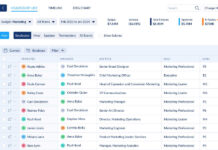
As the workforce evolves to include fewer W-2 employees, more vendors are exploring systems that allow companies to manage their people in a unified way, regardless of whether they’re full-time or contingent. The challenge goes beyond technology: It involves culture, collaboration between HR and Procurement and a retuning of management’s mindset.
SAP, with its SuccessFactors and Fieldglass units, has positioned itself smack in the middle of this changing dynamic. Against that background, we spoke with Fieldglass President Robert Brimm and Vice President Sara Sullivan during this summer’s SAP SAPPHIRE conference.
SAP seems to do a lot of thinking about the impact of contingent workers. After all, people at both Fieldglass and SuccessFactors talk a lot about “the total workforce.” Where do you think it’s all heading?
Sara Sullivan: We definitely recognize that there’s two ways in which clients are trying to solve for this. There’s your employees and then there’s this very large external workforce, and we’re seeing that growing. Nowadays, we’re seeing 44 percent of what organizations spend on the total workforce is on external workers.
That’s about half, right? So if you’re only trying to solve [issues] for your employee base, you’re missing half of how your organization takes a product to market, how fast you’re able to react to what’s going on in the markets, how you can manage your overall cost structure, how you can deliver better performance to the bottom line.
A lot of vendors tell me they know this is an issue, but they aren’t hearing about it from their customers. If they come at them with a solution, the customers don’t have any interest. Do you find that, also, or is it changing?

Rob Brimm: Our go-to-market approach is to call on the lines of business that actually have this problem. We tend to call directly on those who have the need, and once we call those individuals, they’ve defined the need. Given that we’ve been around for 17 years, given our customer base, it’s just a matter of awareness. Oftentimes you have to ask the right questions to the right people, where the issue is really prevalent for them.
But the thing is Fieldglass was basically a vendor management system…
Brimm: That’s the category that we’re in, but it’s a bit of a misnomer. It drives me crazy that it’s called vendor management. But that’s where we started. That’s how people referred to us.
Sullivan: [Our focus now is] on all the external workforce. For many organizations, contingent workers only represent anywhere from 10 to 20 percent of the total external workforce. The larger majority is actually living in the world of outsource service providers.
And then there’s this growing category, the freelancer space. This is the idea of a lot of people choosing to work with organizations and organizations recognizing this is where they have to go for certain types of skill sets and talent.
So when we look at the total external workforce, it’s really made up of those three components: the contingent, the outsourced service providers and the freelancers
SAP is coming at it from both angles, but what’s the shared vision of Fieldglass and SuccessFactors? Does the answer require a change in HR’s role—so the hiring manager doesn’t get to just pick the freelancer anymore, for example? My point is there’s culture change as well as technical change required. What’s your thinking about that?
Brimm: There is cultural change, but it’s where this function needs to come together and people need to be aware of that. The statistics bear it out. Forty-four percent of the spend for labor is actually external. So in terms of looking at this holistically, that’s the way HR should be thinking. Our workforce isn’t just W-2. It includes this other population, also. So we have integration with SuccessFactors so you’re able to go from workforce planning to execution.
This is what we call a position within, for lack of a better term, the permanent population. You’re able to plan for how much of your workforce is going to be put into this bucket versus that bucket, with dates and positions and your needs and it all kind of flows. It’s giving employers the tools and visibility to make holistic decisions, and it’s evolving the way they’re looking at the total picture. But it is happening. It’s raising consciousness and having people make informed decisions versus decisions that just happen to be made by managers. There should be some rigor around this that follows HR policy.

That implies that HR and company leaders are aware that these things have to come together. But is that really happening?
Sullivan: I think we’re finding customers are at different levels. Some absolutely see the value of having total workforce visibility and of understanding who all of these people are that they engage in order to get work done. Then there are other organizations who are still saying, “Oh, I didn’t realize that this is something I should be looking at.”
Part of the challenge is that many organizations struggle to answer core questions around who’s working for them, what they’re doing, where they are, what they’re being paid. The company can answer those questions for their employees, but many organizations struggle to answer them for their external workforce, and I think those organizations are starting to wake up and say, “Wow, 44 percent of this is external—I need to be able to answer those four questions.” I need a solution like Fieldglass to deliver that other components of management that I’m missing today.
What’s the typical size of a Fieldglass customer?
Brimm: Our traditional market was companies that were a billion dollars in annual revenue and above. But [in 2017], we released a product [Flex] which is geared toward the mid-market, which is $300 million to $1 billion. So there’s two different products we have to serve those different markets.
Of those two groups, which do you think is paying more attention to issues around external workers?
Brimm: The larger customers. This is a huge part of their expense base, at 44 percent of their labor cost. Seventy percent of your enterprise, in terms of your overall cost structure, is associated with Labor. So it’s big.
We have clients who spend billions of dollars on these categories. When something’s in the millions—when it gets to be about $10 million that you’re spending, at least in the way we look at it—you should start actively managing it. Our mid-market product allows you to go down to much smaller levels, like $3 million or $4 million.
Sullivan: But it’s growing, right? I mean, even if you look at the mid-market, they’re utilizing more and more outsourced service providers and freelancers because that’s where they have to go to get certain skill sets. So these midsize companies, the high-growth ones, they’re typically big users of outsourcing services.
Is there tension between Procurement and HR over this, do you think? When I’ve dealt with procurement departments, I’ve found them to be very proprietary about what they do. Is there a culture clash going on?
Brimm: I wouldn’t call it a culture clash. We’re using procurement techniques to solve an HR problem. Within that there’s the question of who owns this, and that’s where the tension comes from. Evolved companies are saying, “We have a problem to solve and let’s solve it together.” What we tend to find is that there’s a partnership between HR and Procurement.
Our whole concept is to apply full visibility. Procurement departments want visibility and they also want controls so that you’re following their policies, which we think are good things to do. [They’re saying] “these are the preferred suppliers, we’ve negotiated rates with them,” or, “You can’t just go out and hire freelancers without knowing the true nature of the hiring manager’s relationship with that freelancer. There needs to be sort of some vetting. There’s some legal issues associated with that. Are they qualified?”
There’s good reasons to have some rigor around this. So I’d say it’s a shared partnership, not with tension but a little bit of a hot potato involved in terms of who’s really the sponsor of this. We’re in this interesting category that fits within both the HR side and Procurement. We fit into both because we’re part of the people management and we’re part of the total spend management.
Sullivan: We have this very tight integration and solution between SuccessFactors and Fieldglass because if you’re a manager, you don’t know where to go and you shouldn’t have to know. The solution should solve that for you. When you need to go do something, it should tell you where to go.
That’s where this integration makes it really simple. You don’t have to be an expert, you don’t have to know policies and procedures and systems and solutions. You just go in and when you say, “I need an external worker,” it automatically directs you to the right spot. Or if I’m trying to hire an employee, I’m in the right solution.
I think that’s where SAP says we need to bring all of these solutions together for our customers to make sure that it’s one simplified, one single user experience that makes it easy for the end user, whether they’re buying a new phone or they’re booking a trip or they’re engaging with a service provider or a freelancer. It needs to be simple.















